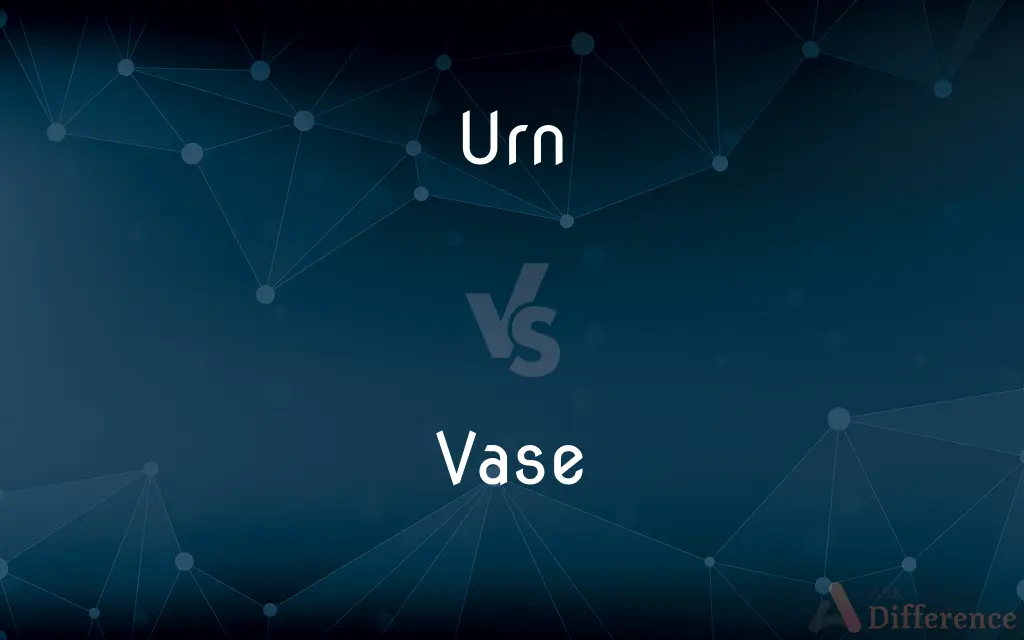Urn vs. Vase — What's the Difference?
By Maham Liaqat & Fiza Rafique — Updated on March 26, 2024
Urn is used for ashes or as a decorative piece; vase is primarily for displaying flowers.

Difference Between Urn and Vase
Table of Contents
ADVERTISEMENT
Key Differences
An urn is a type of container, often with a narrow neck and a rounded body, traditionally used for storing the ashes of a deceased person after cremation. While urns can also serve decorative purposes, their association with funerary practices is prominent. On the other hand, a vase is a container typically used to hold cut flowers. It is designed with aesthetics in mind, coming in various shapes and sizes to complement the beauty of the flowers it displays.
Urns are characterized by their specific use in funerary contexts, although they are also used decoratively or for storing things in some cultures. Vases, however, are more versatile in terms of usage, primarily serving as decorative pieces in homes and public places to enhance the environment with floral arrangements.
While both urns and vases can be made from a variety of materials such as ceramic, metal, glass, or wood, the design and functionality of urns are often influenced by their ceremonial use. Vases, in contrast, are designed with a focus on aesthetic appeal and practicality for displaying flowers, making them more varied in style and form.
The shape of an urn is typically more standardized, with a base, a rounded body, and a narrow neck, sometimes featuring a lid. Vases, however, can range widely in shape—from tall and slender to wide and bulbous—depending on their intended use and the types of flowers they are designed to hold.
Despite their differences, both urns and vases play significant roles in human culture and art. Urns carry profound cultural and emotional significance, often commemorating the deceased, while vases are celebrated for their artistic and functional value in enhancing the beauty of living spaces.
ADVERTISEMENT
Comparison Chart
Primary Use
Storing ashes, decorative
Holding flowers, decorative
Cultural Significance
Funerary practices, commemoration
Art, interior decoration
Design Influence
Ceremonial use
Aesthetic appeal, practicality for flowers
Typical Shape
Rounded body, narrow neck, lid
Varied shapes, often no lid
Material Variety
Ceramic, metal, glass, wood
Ceramic, glass, metal, various others
Compare with Definitions
Urn
Designed with both functionality and aesthetics in mind.
The ceramic urn was beautifully painted.
Vase
Designed to complement the beauty of flowers.
The vase's narrow neck supported the bouquet perfectly.
Urn
A container for ashes after cremation.
The family placed the ornate urn on the mantle.
Vase
Comes in various shapes and sizes for decorative purposes.
The tall glass vase was perfect for the long-stemmed lilies.
Urn
Often used in funerary contexts or as a decorative piece.
An ancient urn was displayed in the museum's collection.
Vase
A container primarily used to display flowers.
She filled the vase with fresh roses.
Urn
Sometimes features a lid or seal.
They sealed the urn with a lid after the ceremony.
Vase
Can be a piece of art in its own right.
The vase on display was a masterpiece of early pottery.
Urn
An urn is a vase, often with a cover, with a typically narrowed neck above a rounded body and a footed pedestal. Describing a vessel as an "urn", as opposed to a vase or other terms, generally reflects its use rather than any particular shape or origin.
Vase
Often found in homes and public places for decoration.
Colorful vases adorned the hotel lobby.
Urn
A tall, rounded vase with a stem and base, especially one used for storing the ashes of a cremated person.
Vase
A vase ( or ) is an open container. It can be made from a number of materials, such as ceramics, glass, non-rusting metals, such as aluminium, brass, bronze, or stainless steel.
Urn
A large metal container with a tap, in which tea or coffee is made and kept hot, or water for making such drinks is boiled
A tea urn
Vase
An open container, as of glass or porcelain, used for holding flowers or for ornamentation.
Urn
Place in an urn.
Vase
An upright open container used mainly for displaying fresh, dried, or artificial flowers.
Urn
A vase of varying size and shape, usually having a footed base or pedestal, especially a lidded vase used to hold the ashes of one who has been cremated.
Vase
(architecture) The body of the Corinthian capital.
Urn
A closed metal vessel having a spigot and used for warming or serving tea or coffee.
Vase
A vessel adapted for various domestic purposes, and anciently for sacrificial uses; especially, a vessel of antique or elegant pattern used for ornament; as, a porcelain vase; a gold vase; a Grecian vase. See Illust. of Portland vase, under Portland.
No chargers then were wrought in burnished gold,Nor silver vases took the forming mold.
Urn
(Botany) The spore-bearing part of a moss capsule.
Vase
A vessel similar to that described in the first definition above, or the representation of one in a solid block of stone, or the like, used for an ornament, as on a terrace or in a garden. See Illust. of Niche.
Urn
A vase with a footed base.
Vase
The calyx of a plant.
Urn
A metal vessel for serving tea or coffee.
Vase
An open jar of glass or porcelain used as an ornament or to hold flowers
Urn
A vessel for the ashes or cremains of a deceased person.
Urn
(figurative) Any place of burial; the grave.
Urn
A measure of capacity for liquids, containing about three gallons and a half, wine measure. It was half the amphora, and four times the congius.
Urn
(botany) A hollow body shaped like an urn, in which the spores of mosses are contained; a spore case; a theca.
Urn
(transitive) To place in an urn.
Urn
Fig.: Any place of burial; the grave.
Or lay these bones in an unworthy urn,Tombless, with no remembrance over them.
Urn
A measure of capacity for liquids, containing about three gallons and a haft, wine measure. It was haft the amphora, and four times the congius.
Urn
A hollow body shaped like an urn, in which the spores of mosses are contained; a spore case; a theca.
Urn
A tea urn. See under Tea.
Urn
To inclose in, or as in, an urn; to inurn.
When horror universal shall descend,And heaven's dark concave urn all human race.
Urn
A large vase that usually has a pedestal or feet
Urn
A large pot for making coffee or tea
Common Curiosities
Why do urns sometimes have lids?
Urns have lids to securely contain ashes, reflecting their use in funerary practices.
What materials are urns and vases made from?
Both can be made from materials like ceramic, metal, glass, or wood, but the design and finish may vary based on their intended use.
How does the design of an urn differ from that of a vase?
Urns typically have a more standardized shape with a base, rounded body, and narrow neck, often featuring a lid, while vases have a wider variety of shapes, focusing on aesthetic appeal.
What is the primary difference between an urn and a vase?
The primary difference lies in their use; urns are traditionally used for holding ashes, while vases are used for displaying flowers.
Can both urns and vases be considered art?
Yes, both can be artistically significant, with designs ranging from simple to elaborate, reflecting cultural values and aesthetics.
How should one choose between an urn and a vase?
The choice depends on the intended use—urns for ashes or commemorative purposes and vases for displaying flowers or as decorative objects.
Can an urn be used as a vase?
While traditionally used for ashes, decorative urns can be repurposed as vases, though this is less common.
Can a vase serve any functional purpose other than holding flowers?
Primarily designed for flowers, vases are mainly decorative, though they can hold other items decoratively.
What role do urns and vases play in culture?
Urns have deep cultural and emotional significance in funerary practices, while vases are celebrated for their artistic and functional value in interior decoration.
Is the material of an urn or vase important in its selection?
Yes, the material affects the appearance, durability, and appropriateness for the urn or vase's intended use.
Share Your Discovery

Previous Comparison
Alley vs. Valley
Next Comparison
Heteroreceptor vs. AutoreceptorAuthor Spotlight
Written by
Maham LiaqatCo-written by
Fiza RafiqueFiza Rafique is a skilled content writer at AskDifference.com, where she meticulously refines and enhances written pieces. Drawing from her vast editorial expertise, Fiza ensures clarity, accuracy, and precision in every article. Passionate about language, she continually seeks to elevate the quality of content for readers worldwide.














































